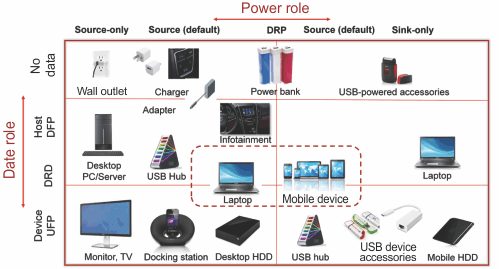SLYY109B February 2021 – March 2022 HD3SS3212 , HD3SS460 , TPD4S311A , TPD6S300A , TPD8S300 , TPS25740A , TPS25750 , TPS65982 , TPS65983B , TPS65987D , TPS65988 , TPS65994AD , TUSB1042I , TUSB1046A-DCI , TUSB1210 , TUSB1310A , TUSB320 , TUSB542 , TUSB544 , TUSB546A-DCI , TUSB564
- At a glance
- Authors
- 3
- Introduction
- Data and power roles
- USB Type-C UFP sink: USB 2.0 without USB PD
- USB Type-C DFP: USB 2.0 without USB PD
- USB Type-C DRP/DRD USB 2.0 without USB PD
- USB Type-C DRP/DRD: USB 2.0 with USB PD
- USB 3.1 Gen 1 (SuperSpeed) and Gen 2 (SuperSpeed+)
- Alternate Mode
- USB Type-C pinout and reversibility
- Conclusion
- References
Data and power roles
There are three types of data flow in a USB connection:
- The downstream-facing port (DFP) sends data downstream; it is typically the port on a host or a hub to which devices connect. A DFP will source VBUS power (the power path between host and device) and can also source VCONN power (to power electronically marked cables). An example of an application that may include a DFP is a docking station.
- The upstream-facing port (UFP), which connects to a host or DFP of a hub, receives the data on a device or hub. These ports usually sink VBUS. An example of an application that may include a UFP is a display monitor.
- The dual-role data (DRD) port can operate as either a DFP (host) or a UFP (device). The port’s power role at attach determines its initial role. A source port takes on the data role of a DFP, while the sink port takes on the data role of a UFP. Using USB PD data-role swap can dynamically change the port’s data role, however. Example applications that may include DRD ports include laptops, tablets and smartphones.
There are three types of power flow in a USB connection:
- A sink is a port that when attached consumes power from VBUS and a sink is most often a device. A sink could include USB peripherals such as a USB-powered light or fan.
- A source is a port that when attached provides power over VBUS. Common sources are a host or hub DFP. An example of a source application is a USB Type-C wall charger.
- A dual-role power (DRP) port can
operate as either a sink or source, and may alternate between these two states.
When a DRP initially operates as a source, the port takes the data role of a
DFP. Alternatively, when a DRP initially operates as a sink, the port takes the
data role of a UFP. Using USB PD power-role swap can dynamically change the
DRP’s power role, however. For example, a laptop may include a DRP port that can
receive power to charge the laptop’s battery, but it can also deliver power to
charge external accessories. Additionally, there are two special subclasses of a
DRP:
- A sourcing device is capable of supplying power, but not capable of acting as a DFP. One example of this subclass is a USB Type-C and USB PD-compatible monitor that receives data from a laptop’s DFP, but also charges the laptop.
- A sinking host is capable of consuming power, but not capable of acting as a UFP. An example could be a hub’s DFP that sends data to an accessory while being powered by that accessory.
Figure 1 below highlights common end equipment and what their typical data and power roles are with regards to the USB Type-C specification.
 Figure 1 USB Type-C version 1.2 example
applications.
Figure 1 USB Type-C version 1.2 example
applications.